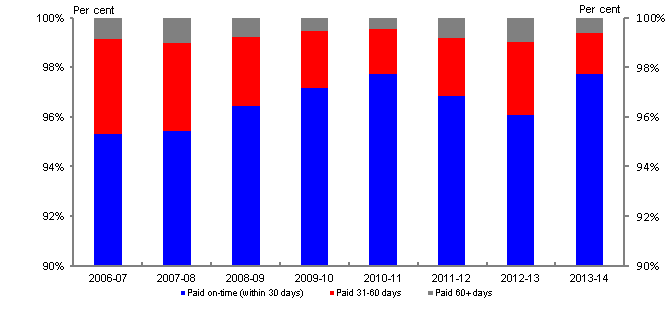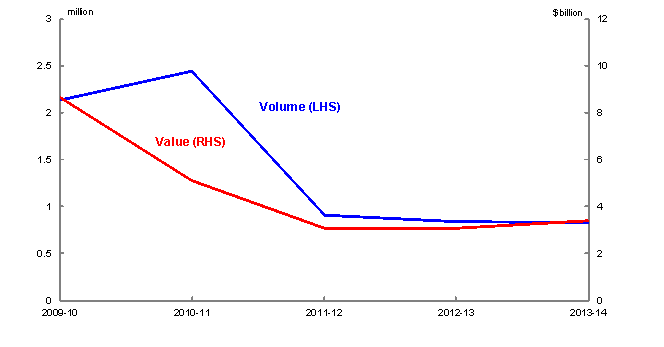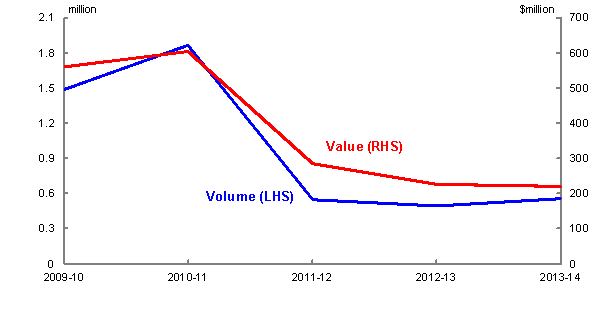Downloads
Survey of Australian Government Payments to Small Business
This report contains the results of the sixteenth survey of Australian Government Payments to Small Business (the survey) for the period 1 July 2013 to 30 June 20141. The survey monitors compliance with the Procurement On-Time Payment Policy for Small Business (the policy). The full policy details are available through the Department of Finance, Finance Circular No. 2012/022.
The key concepts of the policy are:
- For payments valued up to $5 million (GST inclusive) to small businesses, Financial Management and Accountability Act 1997 (FMA Act) agencies must adopt maximum payment terms ‘not exceeding 30 days’.
- For written procurement contracts with small businesses valued up to $1 million (GST inclusive), agencies must pay interest on late payments where the amount of interest accrued is more than $10 in the following circumstances:
- on request from the small business for payments made after 30 days (but before 60 days), from receipt of a correctly rendered invoice; and
- via a self-generated interest payment where payments are made after 60 days from receipt of a correctly rendered invoice.
1. Payment of invoices within 30 days
The survey captures data on payment performance for each FMA Act material agency. The proportion of invoices paid on-time by number and by value were measured. On-time is defined as payments made within 30 days of receiving a correctly rendered invoice from a small business. Agency payment performance is measured against a 90 per cent benchmark in terms of number of invoices paid on-time. The survey data measures the number of invoices paid within 30 days, 31-44 days, 45-60 days and over 60 days late.
The majority of agencies identify small businesses through the standard procurement process, either through tender documentation or when a contract is entered into. Where financial systems could not separately identify small business invoices, agencies were requested to include invoices of up to $5 million (inclusive of GST) as a proxy.
2. Late payment interest penalty
The survey gathered data on the number of requests for interest payments over $10 for invoices paid between 31-60 days to small businesses on invoices valued up to $1 million (inclusive of GST). The value of these late payments was collected and collated with historical survey data to measure performance over time.
In accordance with the policy, the survey data also indicate the number and value of automatic interest payments that were made to small businesses on invoices paid after 60 days, up to $1 million (inclusive of GST) in value, and where interest was more than $10.
3. Appendix
Further detail on the methodology used to deal with the Machinery of Government (MoG) changes that occurred during the 2013-14 reporting period and related Government payment policies are at Appendix A.
Survey highlights
The Australian Government has conducted this survey since 2002. Since that time, there has been a significant improvement in the proportion of invoices paid within 30 days and the number of agencies meeting the 90 per cent benchmark. In 2002 only 82 per cent of invoices were paid on-time. Now in 2013-14, the Australian Government is paying over 97 per cent of invoices on-time.
The number of agencies meeting and exceeding the benchmark continues to improve from a low of 30 per cent (five out of 17) of agencies in 2002 to around 95 per cent (35 out of 37) in 2013-14. This outcome represents an achievement for the Government, particularly as the number of agencies surveyed has grown from 17 in 2002 to 37 in 2014 (see
Table 3)
Chart 1 shows the improvement in overall on-time performance by number against the 90 per cent benchmark. The 2013-14 results (97.74) are the highest aggregated percentage of on-time payments achieved in the survey history. This is a strong result particularly given significant MoG changes that occurred over the 12-month survey period.
Chart 1: Payment performance by number of invoices from 2006-07 to 2013-14

Chart 2 illustrates the value and volume of small business invoices from 2009-10 to 2013-14. There was a sharp decrease in both value and volume of invoices from 2010-11 to 2011-12 but has since remained relatively stable. This sharp decline is explained in part by a change in the reporting methods of the Department of Defence which accounts for a significant proportion of Government procurement. For the 2011-12 reporting period, the Department of Defence was able to better identify and report small business payments, thus excluding payments to larger businesses and reducing the value of payments to small business.
Chart 2: Agency payment performance in terms of invoice volume and value from 2009-10 to 2013-14

2013-14 survey results
The main findings of the 2013-14 survey that measure compliance with the 30 day element of the policy are outlined below.
- The survey reported on 37 agencies3 covering 823,033 invoices worth approximately $3.4 billion. The average value across all invoices was $4,108.
- By number, 97.74 per cent of invoices were paid within 30 days. In terms of value, 94.12 per cent of invoices were paid on-time (see Table 1).
- On-time performance in terms of the total number of invoices has increased slightly from the previous survey period from 96.11 per cent (2012-13) to 97.74 per cent (2013-14).
- Performance in terms of the total value of invoices paid on-time has also increased since the previous survey period from 92.95 per cent (2012-13) to 94.12 per cent (2013-14).
Interest on late payments
Under the policy, small businesses can request interest for invoices paid between 31-60 days on receipt of a correctly rendered invoice for the amount of
interest due. After 60 days, the agency is required to make a self-generated interest payment from receipt of a correctly rendered invoice4.
Penalty interest was applied to 510 invoices. Of these, 130 were requested by small businesses (31-60 days), and 380 were automatically generated by agencies (after 60 days). This is a slight increase from 2012-13 where 465 late payment interest invoices were paid (see Table 2a and 2b).
The total value of interest paid on late invoices in 2013-14 was $47,207 of which $6,729 was paid on late invoices over 30 days and $40,478 on late invoices paid after 60 days. Limitations with the reporting function of financial systems was the main reason for an agency having difficulty complying with the late payment penalty interest aspect of the policy.
In comparison, $35,110 was paid in interest to small businesses in 2012-13. The average amount of interest per late invoice was higher in 2013-14 (approximately $93) compared to 2012-13 (about $76 per invoice). This increase can be explained by the higher number and value of interest generating invoices between 31-60 days (130 invoices valued at $6,729 compared to 12 valued at $3,061 in 2012-13). The increase may also be attributed to the higher value of late payment invoices automatically generated after 60 days ($40,478 compared to $32,049 in 2012-13).
The 2013-14 and 2012-13 results indicate the change in policy from the Procurement 30 Day Payment Policy for Small Business to the Procurement On-Time Payment Policy for Small Business has resulted in more interest being paid to small businesses. In particular, the addition of automatic interest payment after 60 days has resulted in greater interest payments to small business.
| Number of late payment interest invoices | Amount of interest paid ($) | |
|---|---|---|
| 2013 – 2014 (see Table 2b) | 510 | 47,207 |
| 2012 – 20135 | 465 | 35,110 |
| 2011 – 2012 | 50 | 21,6876 |
| 2010 – 2011 | 60 | 3,863 |
| 2009 – 2010 | 33 | 4,821 |
| 2008 – 20097 | 1 | 30 |
| Invoices for interest on late payments 31–60 days (small business requested) | Invoices for interest on late payments over 60 days (agency generated) | Total | |
|---|---|---|---|
| Number | 130 | 380 | 510 |
| Value ($) | 6,729 | 40,478 | 47,207 |
Credit card payments
The survey asks agencies to report on payments that were made by credit card.
Of the total 823,033 invoices, 555,722 were paid by credit card worth approximately $219 million. The average value of a payment made by credit was $394.
By number, the proportion of total invoices paid by credit card is 67.52 per cent. In terms of value, the proportion of total invoices paid by credit card only account for 6.47 per cent (see Table 3).
The majority of credit card payments by number (99.83 per cent of total invoices paid by credit card) and value (99.86 per cent of total value of invoices paid by credit card) were paid within 30 days. The results indicate agencies use credit card payments as a method for paying smaller value payments made upfront
Over time, credit card payments have decreased from 2010-11 in terms of value and volume but have remained fairly stable over the past three years (see Chart 2).
| Number of invoices | Proportion of total number of invoices8 (%) | Value of invoices ($) | Proportion of total value of invoices (%) | |
|---|---|---|---|---|
| Paid within 30 days | 554,796 | 67.41 | 218,417,399 | 6.46 |
| Paid within 31-44 days | 798 | 0.10 | 263,557 | 0.01 |
| Paid within 45-60 days | 98 | 0.01 | 17,243 | <0.00 |
| Paid after 60 days | 30 | <0.00 | 17,078 | <0.00 |
| Total paid late | 926 | 0.11 | 297,879 | 0.01 |
| Total invoices | 555,722 | 67.52 | 218,715,278 | 6.47 |
Chart 2: Agency credit card payments in terms of volume and value from 2009-10 to 2013-14

Agency performance
As previously stated, 37 FMA Act agencies participated in the 2013-14 survey.
By volume, the Department of Industry reported the highest number of invoices with 139,513. This is followed by the Department of Defence with 116,568 and the Department of Agriculture with 84,036.
In terms of value, the Australian Taxation Office reported the highest value of invoices with $803,141,168. Australian Customs and Border Protection Service reported the next highest with $497,866,400 followed by the Defence Materiel Organisation with $318,594,691.
Thirty-five out of 37 agencies (94.59 per cent) met the on-time payment 90 per cent benchmark (see Table 4). In terms of number of on-time payments made to small business, the Attorney-General’s Department paid 100 per cent of their small business invoices on-time. Conversely, two agencies failed to meet the 90 per cent benchmark. The Australian Customs and Border Protection Service had a result of 88.14 per cent and the Department of Parliamentary Services had an outcome of 86.58 per cent for (see Table 5).
| Survey Period | Number of agencies reaching the 90 per cent benchmark out of participating agencies | Percentage (%) |
|---|---|---|
| Jul to June 2013-14 | 35/37 | 94.59 |
| Jul to Jun 2012-13 | 39/40 | 97.50 |
| Jul to Jun 2011-12 | 39/40 | 97.50 |
| Jul to Jun 2010-11 | 40/40 | 100.00 |
| Jul to Jun 2009-10 | 39/41 | 95.12 |
| Jul to Jun 2008-09 | 37/40 | 92.50 |
| Jul to Jun 2007-08 | 32/38 | 84.21 |
| Jul to Jun 2006-079 | 34/39 | 87.18 |
| Jul to Dec 2005 | 27/31 | 87.10 |
| Jan to June 2005 | 26/31 | 83.87 |
| Jul to Dec 2004 | 25/30 | 83.33 |
| Jan to June 2004 | 23/31 | 74.19 |
| Jul to Dec 2003 | 22/29 | 75.86 |
| Jan to Ju n 2003 |
17/29 | 58.62 |
| July to Dec 20021011 | 15/27 | 55.55 |
| Jan to June 20021213 | 5/17 | 29.41 |
Appendix A
Methodology to deal with Machinery of Government (MoG) changes
The Australian Government Payments to Small Business Performance Report is conducted by the Small Business, Competition and Consumer Policy Division within the Treasury. The survey is sent to FMA Act material agencies each year.
At 1 July 2013, there were 40 FMA Act material agencies. From 18 September 2013, the number of FMA Act material agencies was reduced to 38 as a result of the MoG changes. All FMA Act agencies participated in this year’s survey, excluding the
Australian Security Intelligence Organisation due to the nature of their work.
To account for the MoG changes, agencies were asked to report on current and new functions they received for the full 12 month reporting period.
The Department of Education, Employment and Workplace Relations (DEEWR) was abolished and replaced with the Department of Education and the Department of Employment as a result of MOG changes. Due to the difficulty in reporting on the separate education and employment functions prior to the MOG changes, DEEWR is reported in 2013-14 performance report until 17 October 2013. From 18 October 2013 to 30 June 2014, the Department of Employment and the Department of Education are reported as separate agencies (see
Table 5).
Due to the change of agencies over the history of the survey, it is difficult to compare agency results across reporting periods.
Policy changes
There are a number of related Government policies in place to ensure timely payment of invoices to small business.
The Supplier Pay On-Time or Pay Interest Policy (Resource Management Guide No. 417) replaced the Procurement On-Time Payment Policy for Small Business from 1 July 2014. Under this new policy, agencies will automatically pay interest on correctly rendered and unpaid invoices after 30 days, down from the previous 60 days for contracts valued up to $1 million (GST inclusive).
From 1 July 2014, the Public Governance, Performance and Accountability Act 2013 (PGPA Act) replaced the FMA Act and the Commonwealth Authorities and Companies Act 1997 (CAC Act).
The Facilitating Supplier Payment Through Payment CardResource Management Guide No. 416) policy came into effect from 1 July 2014 and articulates the Government’s preferred payment option for credit, debit and charge cards for eligible payments valued below $10,000.
1 Rounding accounts for any apparent summation errors.
2 As of 1 July 2014, this policy has been replaced by the Supplier Pay On-Time or Pay Interest Policy. See
Policy Changes in Appendix A.
3 For the purposes of reporting, the Department of Education, Employment and Workplace Relations is excluded from this number. See
4 Interest payments apply to written procurement contracts with small businesses valued up to $1 million (GST inclusive), where the amount of interest accrued is more than $10. See
5 Introduction of Procurement On-Time Payment Policy for Small Business on 1 September 2012.
6 The large increase in late interest payments are largely attributed to three agencies for this period.
7 Reports approximately six months of data since the Procurement 30 Day Payment Policy for Small Business started on 1 December 2008.
8 See
Table 1 for aggregated payment performance by number and value.
9 No survey was conducted in the period Jan to Jun 2006 in order to transition into financial year reporting.
10 Introduction of 90 per cent benchmark.
11 Includes the participation of material agencies for the first time.
12 Over the period 1 January 2002 to 31 December 2005 eight bi-annual surveys were conducted to monitor compliance with the Procurement 30 Day Payment Policy for Small Business.
13 This first survey was limited to Departments and did not include material agencies.